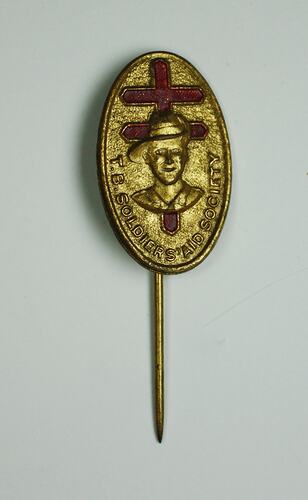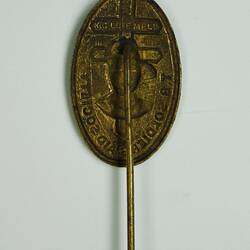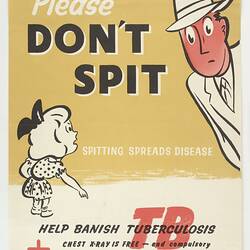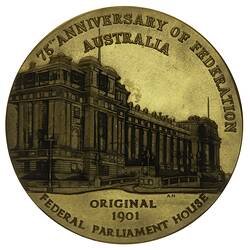Summary
Alternative Name(s): Badge, Pin
Oval-shaped metal lapel pin embossed with bust of soldier with a red cross in the background, inscribed 'T.B. Soldiers' Aid Society'.
According to historian Marina Larsson, the Tubercular Soldiers' Aid Society (TSAS) was an organised group of about 200 volunteers formed in 1921 as a breakaway group from the Tubercular Soldiers' Association (TSA). It provided welfare support to tubercular veterans and their families, and left the public political work of lobbying for pensions to the TSA. Historian Susan Marsden indicates that the Tubercular Soldiers' Aid Society was a South Australian-based organisation, formed from the Tubercular Sailors', Soldiers' and Airmen's Association. Its secretary for many years was Ella Cleggett, a schoolteacher and welfare worker. The TSAS sold badges for several decades to raise funds during its annual appeals. By 1948 the price of the badges had risen to one shilling to raise the increasing funds needed to support ageing former soldiers and their families.
The TSAS provided money, either outright or as loans, to meet the needs of tubercular families, including families of World War I veterans who received no pension. Purchases included foods such as eggs and milk, canvas blinds to enclose verandahs as sufferers were encouraged to sleep in fresh air, and payment of doctors' accounts incurred by family members. Care was arranged for children whose parents could no longer look after them, due to family breakdown, illness, hospitalisation or death. TSAS became, for some, a form of extended family, providing a support network in the face of considerable stigma (tuberculosis was considered highly contagious by some, and sufferers of the 'white plague' were vulnerable to ostracism). The organisation published a newsletter, the Optimist (named by Ella Cleggett), encouraging a positive outlook, and TSAS social events, such as Christmas parties, were often remembered as happy occasions during difficult times. Ella Cleggett contined to work in support of the TSAS into the 1950s.
Other organisations such as the Red Cross also supported tubercular families following World War I.
The provenance of this particular lapel pin is unknown.
Physical Description
Oval-shaped, gold coloured metal lapel pin. The obverse is embossed with bust of soldier, text curving along lower edge and cross in background. Cross coloured with red enamel.
Significance
Tuberculosis was estimated to have effected around 3,000 former Australian servicemen after World War I (according to the Repatriation Department in 1920). Marina Larsson notes that historians have been slow to recognize the place of tuberculosis in the history of war disability (Shattered Anzacs, 2009, pp.178-205).
Some soldiers were thought to have caught tuberculosis in the squalor of the trenches; gas was also believed to make soldiers vulnerable to infection. The disease often developed slowly, and could be passed onto family members. There was no known cure, and rest and fresh air were considered the best approaches to disease management. Soldiers were sometimes isolated and treated in sanatoriums. Death was a very likely outcome, although could take years to occur. It was not until 1944 that first antibiotic and first bacterial agent effective against tuberculosis was isolated.
The lapel pin would have been made as part of a fund-raising drive in support of the work of the TSAS, and provides an insight into one of the many voluntary activities needed in the decades after World War I to support those suffering the long-term impacts of the Great War.
More Information
-
Collecting Areas
Public Life & Institutions, Home & Community, Medicine & Health
-
Acquisition Information
Purchase from Ed Hunter, 10 Jan 2013
-
Date Made
Tubercular Soldiers' Aid Society, South Australia, Australia, 1921 or later
-
Maker
-
Inscriptions
Text curving along lower edge: 'T.B. SOLDIERS' AID SOCIETY'.
-
Classification
-
Category
-
Discipline
-
Type of item
-
Dimensions
18 mm (Width), 29 mm (Height)
Width and height measurements represent the the badge component of pin as visible when worn. Length of pin attached to centre of reverse side: 42mm. Full height of badge with pin: 52mm.
-
References
Marina Larsson, Shattered Anzacs, 2009: pp. 197-98 Susan Marsden, Australian Dictionary of Biography, 'Ella Cleggett', 1884-1960. ASSISTING T.B. SOLDIERS. (1925, March 27). The Register (Adelaide, SA : 1901 - 1929), p. 9. Retrieved August 16, 2019, from [Link 1]
[Book] Larsson, Marina. 2009. Shattered Anzacs.
-
Keywords
World War I, 1914-1918, Tuberculosis, Disabilities, Fundraising




